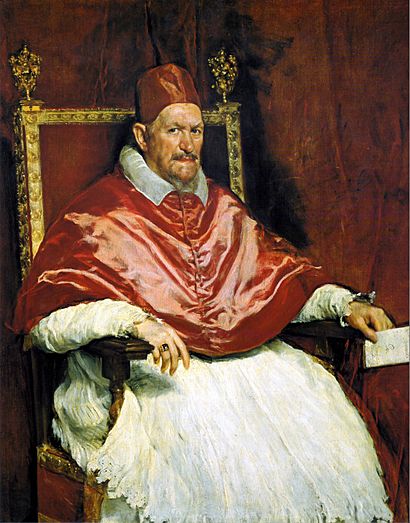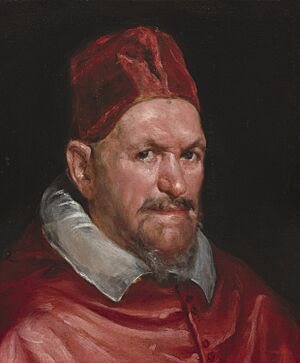Portrait of Innocent X facts for kids
Quick facts for kids Portrait of Innocent X |
|
|---|---|
| Spanish: Retrato de Inocencio X | |
 |
|
| Artist | Diego Velázquez |
| Year | c. 1650 |
| Medium | Oil on canvas |
| Dimensions | 141 cm × 119 cm (56 in × 47 in) |
| Location | Galleria Doria Pamphilj, Rome |
The Portrait of Pope Innocent X is a famous painting by the Spanish artist Diego Velázquez. He painted it around 1650 during a trip to Italy. Many art experts believe it is one of the best portraits ever made. You can see this amazing artwork at the Galleria Doria Pamphilj in Rome, Italy.
There are also other versions of the painting. A smaller one is at the Metropolitan Museum of Art in New York. Another study, which is like a practice painting, is in London at Apsley House. The painting is known for being very realistic. It shows Pope Innocent X as an intelligent, clever, and older man. He is wearing special church clothes made of linen. The painting's quality shines through in the rich red colors of his clothes and the curtains behind him.
Pope Innocent X, whose real name was Giovanni Battista Pamphilj, was not sure about letting Velázquez paint him at first. But he changed his mind after seeing other portraits by the artist. Velázquez had already painted many people close to the Pope. Even so, the Pope was still careful. The painting was first shown only to his family. For a long time, in the 1600s and 1700s, it was not seen by the public.
Creating the Famous Portrait
Velázquez painted this portrait during his second visit to Italy. This trip happened between 1649 and 1651. The Pope's clothes in the painting are light linen. This suggests the painting was likely done in the summer, probably in 1650. Velázquez even signed his name on a piece of paper in the Pope's hand. However, the date is hard to read.
There are different stories about how Velázquez got to paint the Pope. One story says that Velázquez, who was already a famous painter, met Pope Innocent X in Rome. Velázquez offered to paint his portrait. But the Pope was unsure of Velázquez's skills. He asked for proof. So, Velázquez painted a portrait of his helper, Juan de Pareja. This painting is now at the Metropolitan Museum of Art in New York. After seeing that portrait, Pope Innocent X agreed to sit for Velázquez.
When the Pope saw the finished painting, he supposedly said, "È troppo vero! È troppo vero!" This means, "It's too true! It's too true!" Even if he said this, he still knew the portrait was incredibly good. Some experts doubt this story. They think the Pope agreed because Velázquez had already painted other important people in the Pope's court very well. This included the Pope's barber.
The painting stayed with the Pope's family, the Pamphilj family. They kept it in the Doria Pamphilj Gallery, where it is still today. For many years, it was not widely known. Only a few art lovers knew it was one of the best portraits ever. A French historian named Hippolyte Taine called it "the masterpiece amongst all portraits." He also said, "once it has been seen, it is impossible to forget."
Impact on Other Artists
The Portrait of Pope Innocent X has inspired many other artists. In the 1900s, an artist named Francis Bacon created a series of paintings based on it. These are often called the "Screaming Popes." He made more than 45 of these paintings in the 1950s and early 1960s.
Bacon never saw the original painting in person. But it was still a huge influence on his work. You can see its impact in many of his best paintings from the late 1940s to the early 1960s. In Bacon's 1953 version, the Pope is shown screaming. But his voice seems "silenced" by the dark curtains around him. This creates a strange and nightmarish feeling. The pleated curtains in the background even seem to fall through the Pope's face.
A reversed image of the portrait is also on the cover of the 2018 album Prequelle by the band Ghost.
See also
 In Spanish: Inocencio X (Velázquez) para niños
In Spanish: Inocencio X (Velázquez) para niños
- List of works by Diego Velázquez
Sources


